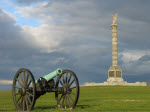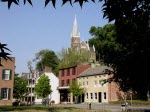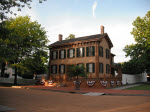Civil War 150th Anniversary: Places and Events that Shaped Our Nation 150 Years Ago
The 150th Anniversary of the Civil War is an unparalleled time to discover, discuss, and commemorate America's greatest national crisis, and explore its relevance to today’s world. More than 70 national parks across the U.S. preserve sites and stories where this epic struggle took place from 1860 to 1865.
In 2012, join friends, families, rangers, re-enactors, history buffs, scholars and your fellow Americans as we look back and examine the events that changed our country forever in the year 1862 — 150 years ago.
Antietam National Battlefield 150th Anniversary
Sharpsburg, Maryland

The Battle of Antietam, September 15, 1862
Did you know that 23,000 soldiers were killed, wounded or missing after 12 hours of savage combat on September 17, 1862? The Battle of Antietam ended the Confederate Army of Northern Virginia's first invasion into the North and led to Abraham Lincoln's issuance of the preliminary Emancipation Proclamation.
Commemorative Event: 150th Anniversary of the Battle of Antietam, September 15-17, 2012
During the commemoration experience tours, hikes, music, children's activities, living history, guest lecturers and memorial ceremonies. A family and youth tent will feature hands-on activities for all ages. Decide which army you will join and discover the stories of the soldiers who fought here. Antietam’s programs are part of a regional effort to commemorate the entire Maryland Campaign of 1862. Five national parks, one Maryland state park, and numerous county and private organizations are working together to provide opportunities across the region from late August through September 22, 2012.
Harpers Ferry National Historical Park
Harpers Ferry, West Virginia

The Battle of Harpers Ferry, September 15-17, 1862
Harpers Ferry is unique in American history. The town saw the first successful application of interchangeable manufacture: the making of uniform parts with machine, laying a solid foundation for America's developing factory system. It saw the arrival of the first successful American railroad, and John Brown's attack on slavery. Harpers Ferry’s strategic location on the Baltimore and Ohio Railroad lines and at the juncture of the Shenandoah and Potomac Rivers ensured that Union and Confederate troops would converge here. The town changed hands eight times between 1861 and 1865.
Later, the town saw the education of former slaves in one of the earliest integrated schools in the United States. Today the historic town preserves the history that unfolded during its many transitions before, during, and after the Civil War.
Commemorative Event: Prelude to Freedom: The 1862 Battle of Harpers Ferry, September 13 -16, 2012
This event chronicles the 3-day Battle of Harpers Ferry in September of 1862 that resulted in the largest surrender of U.S. troops during the American Civil War. Join the Harpers Ferry National Historical Park staff, local residents, visitors, and history experts for this park-wide special Civil War 150th Anniversary event. Activities include: living history, ranger-led programs, family and youth activities, special hikes, bus tours, lectures, a panel discussion, and book signings.
Schomburg Center for Research in Black Culture
New York, New York

In July 1862, President Lincoln read his "preliminary proclamation" to his Cabinet, but decided to wait for a Union military victory to issue it. On September 22, 1862, following the victory at Antietam, he signed the preliminary Emancipation Proclamation, formally alerting the Confederacy of his intention to free all persons held as slaves within the rebellious states if the rebels did not end the fighting and rejoin the Union by January 1, 1863. One hundred days later, with the Confederacy still in full rebellion, President Abraham Lincoln issued the final Emancipation Proclamation.
Commemorative Event: 150th Anniversary of Lincoln’s Preliminary Emancipation Proclamation, September 21-24, 2012
The New York State Museum presents a traveling exhibition to commemorate the 150th anniversary of the Preliminary Emancipation Proclamation. From 9 am-4 pm, Friday, September 21 through Monday, September 24 the New York Public Library’s Schomburg Center for Research in Black Culture will display both the original Official Preliminary Emancipation Proclamation from the National Archives and President Lincoln's handwritten manuscript from the New York Public Library’s collection together for the first time. The Lincoln version will travel to various venues in New York, but the official proclamation will only be available for viewing at the Schomburg.
Learn more...
Lincoln Home National Historic Site
Springfield, Illinois

Abraham Lincoln believed in the idea that everyone in America should have the opportunity to improve his or her economic and social condition. Lincoln’s life was the embodiment of that idea. Many of Lincoln's social and political beliefs were formed while he lived in his home at Eighth and Jackson Streets in Springfield.
Hundreds of thousands of people visit the Lincoln Home every year to learn more about the man who fought for the ideals of freedom and democracy. Even during Lincoln's life, when he was an attorney turned president-elect, people came to Springfield to learn more about Lincoln, his family, and his home.
With a visit to Lincoln Home, follow in the footsteps of the father, husband, lawyer, and statesman who led the nation through the turbulent Civil War.
Learn more...
Ulysses S. Grant National Historic Site
St. Louis County, Missouri

Ulysses S. Grant is well known as the victorious Civil War general who saved the Union and was also the 18th President of the United States. However, few people know about his rise to fame or his personal life.
Grant first met Julia Dent, his future wife, at White Haven, her family home. Grant opposed his father-in-law’s ownership of slaves at White Haven, but recognized his legal right to do so. In March 1859, Grant acted on his beliefs; purchasing William Jones in order to “manumit, emancipate and set free said William from slavery forever.” Today, White Haven, now Ulysses S. Grant National Historic Site, commemorates their lives against the turbulent backdrop of the 19th century.
When the Civil War began in April 1861, Ulysses felt it was his duty to re-enter the military. He soon rose to fame following the battles at Forts Henry and Donelson. Grant soon acquired the nickname "Unconditional Surrender” since those were the terms he gave to the Confederate forces at Donelson. Other battles, especially Vicksburg, brought Grant to the attention of President Abraham Lincoln, who named him general of all Union armies in March 1864.
Learn more...
Stones River National Battlefield
Murfreesboro, Tennessee

The Battle of Stones River, December 31, 1862
The Battle of Stones River began on the last day of 1862 and was one of the bloodiest conflicts of the Civil War. The battle produced important military and political gains for the Union, and forever changed the people who lived and fought there.
As 1862 drew to a close, President Abraham Lincoln was desperate for a military victory. His armies were stalled, and the terrible defeat at Fredericksburg spread a pall of defeat across the country. The nation needed a victory to bolster morale and support the Emancipation Proclamation when it went into effect on January 1, 1863.
On December 26, 1862, the Union Army of the Cumberland left Nashville to meet the Confederates in Murfreesboro where they were camped, protecting the rich farms of Middle Tennessee that were feeding their men. This was the beginning of the Stones River Campaign.
Commemorative Event: 150th Anniversary Programs, December 26, 2012 to January 2, 2013
Join rangers and volunteers for a variety of walks, talks, tours and living history demonstrations that will tell the story of one of the most significant battles of the Civil War, the Battle of Stones River. The highlight will be a series of living history programs and weapons demonstrations on December 29-30, 2012, featuring 250-300 soldiers.
The Underground Railroad

The Underground Railroad refers to the efforts – sometimes spontaneous, sometimes highly organized – to assist persons held in bondage in North America to escape from slavery. Historic places along the Underground Railroad are a testament to African American capabilities. The network provided an opportunity for sympathetic white Americans to play a role in resisting slavery, and brought together, however uneasily at times, men and women of both races to begin to set aside assumptions and try to work together on issues of mutual concern.
Learn more...













